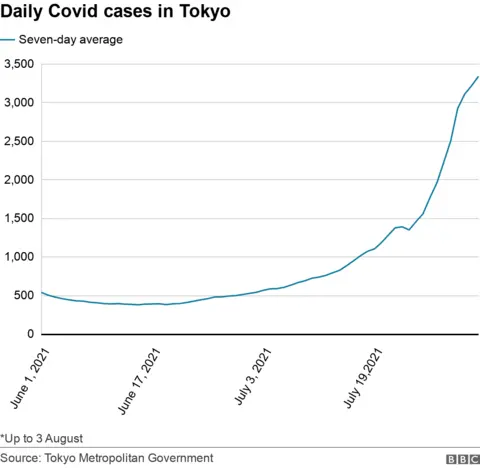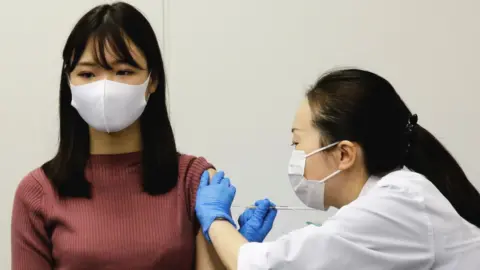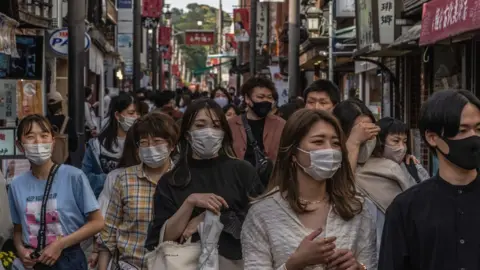Tokyo 2020: What's happening to Covid during the Olympics?
 AFP
AFPWith the Tokyo Olympics in their final week, new cases of Covid continue to be identified at the Games, and across Japan.
Infection numbers have been climbing for some time, and there's a state of emergency in place in Tokyo and five other areas until 31 August.
How many cases are there at the Olympics?
Data collected by the International Olympic Committee (IOC) shows that as of 4 August, they had reported more than 320 Covid cases linked to the Olympics since 1 July.
This includes not just athletes, but also employees of the Olympics organising committee and of national committees as well as contractors and other employees and volunteers working at the games, as well as members of the media.
Most of the cases were Japanese nationals, and many were amongst contractors providing services for the Games.
But there have also been cases among foreign nationals - mostly amongst officials and staff associated with overseas teams and national Olympic committees rather than amongst the athletes themselves.
There are strict Covid safety rules in place inside venues limiting what competitors and officials can do and where they can go, and athletes and others are being tested daily.
Two silver medal-winning athletes from Georgia were removed from the Games after they were seen in Tokyo outside the Olympic venues.
How many cases are there across Japan?
Daily infections have been rising, surpassing the earlier peaks in January and May this year.
The figure for daily cases averaged over seven days is well above the levels seen during previous peaks earlier this year, although the number of deaths is much lower.
According to Our World in Data, as of 26 July over 75% of the cases were linked to the more transmissible Delta variant.
In the host city of Tokyo, experts said the daily infection rate should be below 100 in order to hold the Games safely.

Case numbers did fall from mid-May, although they never got down to 100 a day.
But that decline has now reversed and infections have risen sharply.
The city's health authorities have reported a seven-day average of more than 3,000 cases a day since 1 August.
A state of emergency is in force in Tokyo, and Olympic events there and in Fukushima prefecture are taking place without spectators.
The emergency in the capital is being extended until the end of August, and will also apply to some neighbouring regions as well.
For Tokyo, there are specific measures in place such as limits on opening hours for bars and restaurants, and restrictions on serving alcohol.
Residents of the capital have also been advised to avoid non-essential journeys, wear masks and work from home.
How many people has Japan vaccinated?
As of 3 August, just over 30% of people in Japan were fully vaccinated.
The US, France and Germany have around half or more than half of their populations fully vaccinated, and in the UK, more than 56% of people are now fully vaccinated.
Japan only started vaccinating people in February, later than most other developed nations.
The Pfizer jab was, for some months, the only approved vaccine in Japan.
This process took longer because Japan insisted on doing its own trials alongside the tests done internationally.
 Reuters
ReutersOfficials say this was done to build confidence in the vaccine, according to the Asahi Shimbun newspaper.
Historical concerns surrounding side effects have contributed to hesitancy towards inoculations in the past.
An Imperial College London study of 15 countries found that Japan had the lowest levels of trust towards the coronavirus vaccines.
The rollout has also been hampered by supply shortages and bureaucratic hurdles.
What other measures has Japan taken?
Japan - unlike some other countries - did not enforce strict lockdowns or completely close off its borders as soon as the pandemic hit last year.
 Getty Images
Getty ImagesIn April 2020, the government introduced a state of emergency, although the stay-at-home guidelines were voluntary. Non-essential businesses were asked to close, but did not face penalties for not complying.
Restrictions on entry were introduced from some countries, and others were added later on, with entry now barred from 159 countries (except in special circumstances).
Although it has a large elderly population and densely-populated urban centres, Japan proved relatively successful in controlling the virus initially, and avoiding high death rates.
There were a number of theories put forward as to why this might have been, including:
- high public compliance with safety measures such as mask wearing
- close physical contact like hugging and kissing is generally avoided
- lower rates of chronic disease like heart conditions, obesity and diabetes
 Getty Images
Getty ImagesHowever, there were outbreaks of the virus throughout 2020 and nationwide, case numbers rose sharply in the latter part of the year and into a peak this January.
At the time, the government faced criticism over a campaign encouraging domestic travel in order to boost the economy.

